To maintain your classic car’s performance, grasp how points and condensers work. Points act as a circuit switch controlled by the distributor cam. When closed, sparks generate for ignition.
The condenser reduces arcing. Regular maintenance extends component life and enhances engine function. Signs of problems include misfires and rough idling.
Adjust points with feeler gauges and clean pitted points for peak performance. Upgrading to electronic ignition enhances reliability and efficiency, eliminating the need for points and condensers.
Learning more about points and condensers can help keep your classic car running smoothly.
What You Need to Know
- Points and condenser maintenance optimizes classic car performance and prevents wear.
- Regular tune-ups extend the lifespan of ignition components.
- Signs of issues include engine misfires, rough idling, and difficulty starting.
- Adjust points and condenser for proper operation and timing accuracy.
- Consider upgrading to electronic ignition for enhanced reliability and performance benefits.
The Basics of Points and Condenser

In classic car maintenance, understanding the basics of points and condenser is essential for ensuring proper ignition system performance.
Points in this system act as a switch controlled by the distributor shaft cam. When closed, they complete the circuit, energizing the coil for spark generation.
As they open, the coil releases stored energy, creating the spark needed for ignition.
The condenser plays an important role in reducing arcing across points, extending their lifespan and ensuring consistent spark generation.
Historically, points and condenser systems were prevalent in older vehicles, but modern cars have shifted to electronic ignition systems for improved efficiency and reliability.
However, classic cars still rely on these components for their ignition systems.
Troubleshooting tips for points and condenser systems include checking for pitting or burning on the points, ensuring proper point gap, and testing the condenser for functionality.
Common misconceptions include neglecting these components during maintenance, which can lead to ignition issues.
Proper maintenance of points, condenser, and distributor components is essential for optimal ignition system performance in classic cars.
Importance of Regular Maintenance
Regular maintenance of points and condenser components in classic cars is essential for ensuring top ignition system performance.
By conducting regular tune-ups and inspections, you reap maintenance benefits that go beyond just preventing breakdowns.
Proper maintenance plays a significant role in performance optimization, as it prevents premature wear and pitting on contact breaker points, which are essential for generating the spark needed to ignite the fuel-air mixture in the engine.
Consistent maintenance not only extends the lifespan of points and condenser components but also ensures smooth engine operation.
Ignition system tune-ups are important for avoiding misfires and other engine performance issues related to the ignition system.
Therefore, by staying on top of maintenance tasks, you’re not just keeping your classic car in good shape, but you’re also guaranteeing that it performs at its best every time you hit the road.
Signs of Points and Condenser Issues

To identify potential points and condenser issues in your classic car, watch out for specific signs that indicate these components may be malfunctioning.
Common symptoms of points and condenser problems include engine misfires, rough idling, and poor performance.
If you notice difficulty starting the engine or experience decreased fuel efficiency, these could be indications of underlying issues with the points and condenser.
A failing condenser can also lead to points burning out quickly, necessitating more frequent maintenance.
Ignoring these signs may result in eventual engine stalling and complete ignition system failure, causing more significant issues down the line.
To troubleshoot potential points and condenser issues, it’s important to conduct regular inspections and promptly replace these components when needed.
Steps to Adjust Points and Condenser
Fine-tuning points and condenser in classic cars requires precision and attention to detail to guarantee peak engine performance.
To adjust points, use feeler gauges to set the specific gap needed for proper coil and condenser operation.
Make sure that the points are adjusted at the maximum gap with the cam lobes to achieve accurate timing, a critical factor in engine tuning.
Regularly replacing the condenser is essential to prevent the points from burning out and maintain efficiency in vintage restoration projects.
When troubleshooting issues, consider cleaning or renewing pitted points with fine wet and dry paper to optimize performance.
Remember, proper maintenance of points and condenser is essential for smooth engine operation in classic cars.
For performance upgrades, focus on these steps to fine-tune your engine for excellent vintage restoration and keep your classic car running at its best.
Upgrading to Electronic Ignition

Consider upgrading your classic car to electronic ignition for enhanced reliability and performance.
By making this switch, you can enjoy numerous benefits such as improved spark timing precision, better fuel efficiency, easier starting, smoother idling, and reduced maintenance requirements.
Electronic ignition systems eliminate the need for points and condensers, offering a more efficient and reliable solution for your classic vehicle.
When it comes to the installation process, retrofit kits are available to help you convert your car to an electronic ignition system.
These kits come with detailed instructions and all the necessary components for a straightforward upgrade.
The process typically involves removing the old points and condenser, installing the new electronic ignition module, connecting the wiring harness, and setting the ignition timing according to the manufacturer’s specifications.
With a bit of time and effort, you can enjoy the benefits of electronic ignition and enhance the performance of your classic car.
As an Amazon Associate we earn from qualifying purchases.










